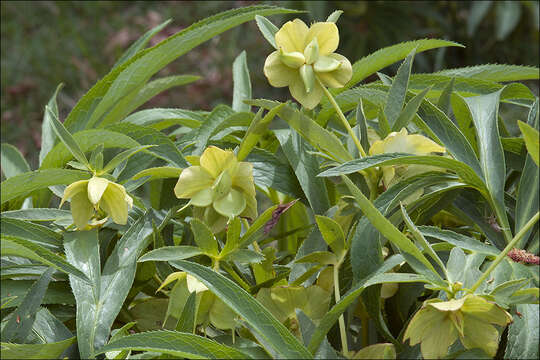Helleborus-multifidus-ssp-istriacus_2

Description:
Helleborus multifidus ssp. istriacus Vis. (Schiffner) Merxm. & Podl., syn.: Helleborus istriacus (Schiffn.) Borbas, Helleborus odorus Waldst. et Kit. var. istriacus Schiffn., Helleborus viridis subsp. istriacus (Schiffn.) Cristof. & ZanottiLacy Hellebore (?), DE: Istrische Vielspaltige Nieswurz, Istrische NieswurzSlo.: istrski deljenolistni teloh, istrski telohDat.: Apr. 23. 2015Lat.: 45.08763 Long.: 14.45765Code: Bot_0866/2015_DSC5865Habitat: grassland, edge of a pasture next to mixed hardwood forest; locally flat terrain; calcareous, skeletal ground; dry, partly shady, rather open place; exposed to direct rain; elevation 130 m (430 feet); average precipitations ~ 1.000 mm/year, average temperature 13-15 deg C, Sub-Mediterranean phytogeographical region. Substratum: soil.Place: West part of the island Krk, about 500 m north of village Milohnii; Kvarner bay archipelago, Adriatic Sea, Croatia EC.Comment: Taxonomy of the genus Helleborus is 'complex'. Several interpretations exist. The two main reasons are: very frequent occurrences of intermediated forms between species and many and frequent hybrids. Helleborus multifidus ssp. istriacus had been for decades considered as a subspecies of similar Helleborus odorus. Once it was also considered a subspecies of Helleborus viridis. Other authors consider it on species level as Helleborus istriacus. Following the key in Rottersteiner (2014), Ref.: 1 the photographed plants belong to Helleborus multifidus ssp. istriacus due to its palmatelly divided ground leaves with many leaflets (10-15), which are deeply incised, some nearly to the bottom of the leaf and some to about one half of the leaflet length. The leaf edge is finely and sharply serrated (toothed with teeth directed forward). The leaflets should be wider than 15 mm in contrast to very similar subspecies Helleborus multifidus ssp. multifidus, which is supposed to have narrower leaflets. To distinguish both is many times difficult. This is particularly true (including Helleborus odorus) in early spring in March when plants bloom. The ground leaves are not yet developed at that time and the flower stalks and flowers are very variable in all of them. These pictures show plants already forming seeds.The Helleborus multifidus ssp. istriacus is endemic to peninsula Istria and surrounding regions including Kvarner archipelago islands. Apart of this it can be found also in Croatia's central-western part. It grows also in southwest Slovenia, as well as in most northwest part of Italy near the town Trieste.Ref.:(1) W.K. Rottensteiner, Exkursionsflora fr Istrien, Verlag des Naturwissenschaftlichen Vereins Krten (2014), p 787.(2) A. Martini et all., Mala Flora Slovenije (Flora of Slovenia - Key) (in Slovenian), Tehnina Zaloba Slovenije (2007), p 127. (3) J. Bavcon, K. Eler, A. Suek, Helleborus (Helleborus L.), University Botanic Gardens Ljubljana (2012), p 43.
Included On The Following Pages:
- Life (creatures)
- Cellular (cellular organisms)
- Eukaryota (eukaryotes)
- Archaeplastida (plants)
- Chloroplastida (green plants)
- Streptophyta
- Embryophytes
- Tracheophyta (ferns)
- Spermatophytes (seed plants)
- Angiosperms (Dicotyledons)
- Eudicots
- Ranunculales (Red Columbine)
- Ranunculaceae (buttercup family)
- Helleborus (Hellebore)
- Helleborus bocconei
- Helleborus bocconei siculus
This image is not featured in any collections.
Source Information
- license
- cc-by-nc-sa
- copyright
- Amadej Trnkoczy
- photographer
- Amadej Trnkoczy
- original
- original media file
- visit source
- partner site
- Flickr Group
- ID


